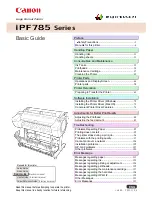
Configuring Settings for Key Pairs and Digital
Certificates
0W20-04R
In order to encrypt communication with a remote device, an encryption key must be sent and received over an
unsecured network beforehand. This problem is solved by public-key cryptography. Public-key cryptography ensures
secure communication by protecting important and valuable information from attacks, such as sniffing, spoofing, and
tampering of data as it flows over a network.
Key Pair
A key pair consists of a public key and a secret key, both of which are required for encrypting or
decrypting data. Because data that has been encrypted with one of the key pair cannot be
returned to its original data form without the other, public-key cryptography ensures secure
communication of data over the network. Up to five key pairs, including the preinstalled pairs,
can be registered ( Using CA-issued Key Pairs and Digital Certificates(P. 262) ). For SSL
encrypted communication, a key pair can be generated for the machine ( Generating Key
Pairs(P. 254) ).
CA Certificate
Digital certificates including CA certificates are similar to other forms of identification, such as
driver's licenses. A digital certificate contains a digital signature, which enables the machine to
detect any spoofing or tampering of data. It is extremely difficult for third parties to abuse
digital certificates. A digital certificate that contains a public key of a certification authority (CA)
is referred to as a CA certificate. CA certificates are used for verifying the device the machine is
communicating with for features such as printing with Google Cloud Print or IEEE 802.1X
authentication. Up to 67 CA certificates can be registered, including the 62 certificates that are
preinstalled in the machine ( Using CA-issued Key Pairs and Digital Certificates(P. 262) ).
◼
Key and Certificate Requirements
The certificate contained in a key pair generated with the machine conforms to X.509v3. If you install a key pair or a CA
certificate from a computer, make sure that they meet the following requirements:
Format
●
Key pair: PKCS#12
*1
●
CA certificate: X.509v1 or X.509v3, DER (encoded binary)
File extension
●
Key pair: ".p12" or ".pfx"
●
CA certificate: ".cer"
Public key algorithm
(and key length)
RSA (512 bits, 1024 bits, 2048 bits, or 4096 bits)
Certificate signature algorithm
SHA1-RSA, SHA256-RSA, SHA384-RSA
*2
, SHA512-RSA
*2
, MD5-RSA, or MD2-RSA
Certificate thumbprint algorithm SHA1
*1
Requirements for the certificate contained in a key pair are pursuant to CA certificates.
*2
SHA384-RSA and SHA512-RSA are available only when the RSA key length is 1024 bits or more.
●
The machine does not support use of a certificate revocation list (CRL).
Security
253
Summary of Contents for imageclass LBP251dw
Page 1: ...LBP252dw LBP251dw User s Guide USRMA 0786 00 2016 06 en Copyright CANON INC 2015 ...
Page 35: ...LINKS Using the Operation Panel P 30 Basic Operations 29 ...
Page 69: ...Exiting Sleep Mode Press any key on the operation panel Basic Operations 63 ...
Page 75: ...Printing 69 ...
Page 83: ...LINKS Basic Printing Operations P 70 Checking the Printing Status and Log P 78 Printing 77 ...
Page 117: ...LINKS Printing via Secure Print P 112 Printing 111 ...
Page 122: ...Checking the Printing Status and Log P 78 Printing 116 ...
Page 178: ...3 Click OK 4 Click Close LINKS Setting Up Print Server P 173 Network 172 ...
Page 233: ...LINKS Configuring Printer Ports P 168 Security 227 ...
Page 316: ...0 Auto Shutdown is disabled 1 to 4 to 8 hr Setting Menu List 310 ...
Page 355: ...Troubleshooting 349 ...
Page 470: ...Appendix 464 ...
Page 478: ...Manual Display Settings 0W20 08J Appendix 472 ...
















































